Highlights from the 50th International Symposium on High Performance Liquid Phase Separations and Related Techniques
After three “lost” years, the 50th International Symposium on High Performance Liquid Phase Separations and Related Techniques, or HPLC 2022, returned. The symposium was held at the Town and Country Hotel and Conference Center in sunny San Diego, California, USA, from 18–23 June 2022. The HPLC symposium continues to be the premier event bringing together leading scientists in the field of liquid chromatography (LC) and related techniques. The conference was chaired by Frantisek Svec of Charles University and, especially under the uncertain times leading up to the event, was very successful and welcomed by the attendees.
In this instalment of “Column Watch”, we report on the observed highlights and trends from the HPLC 2022 conference. In a similar fashion to the previous HPLC symposium review articles (1–3), many colleagues in attendance at the symposium were asked for their insights regarding the most interesting topics they observed at the event. Figure 1 attempts to capture the major topics of interest as determined by attendees in an infographic gleaned from these responses, and what follows is a synopsis of highlighted topics along with some personal views.
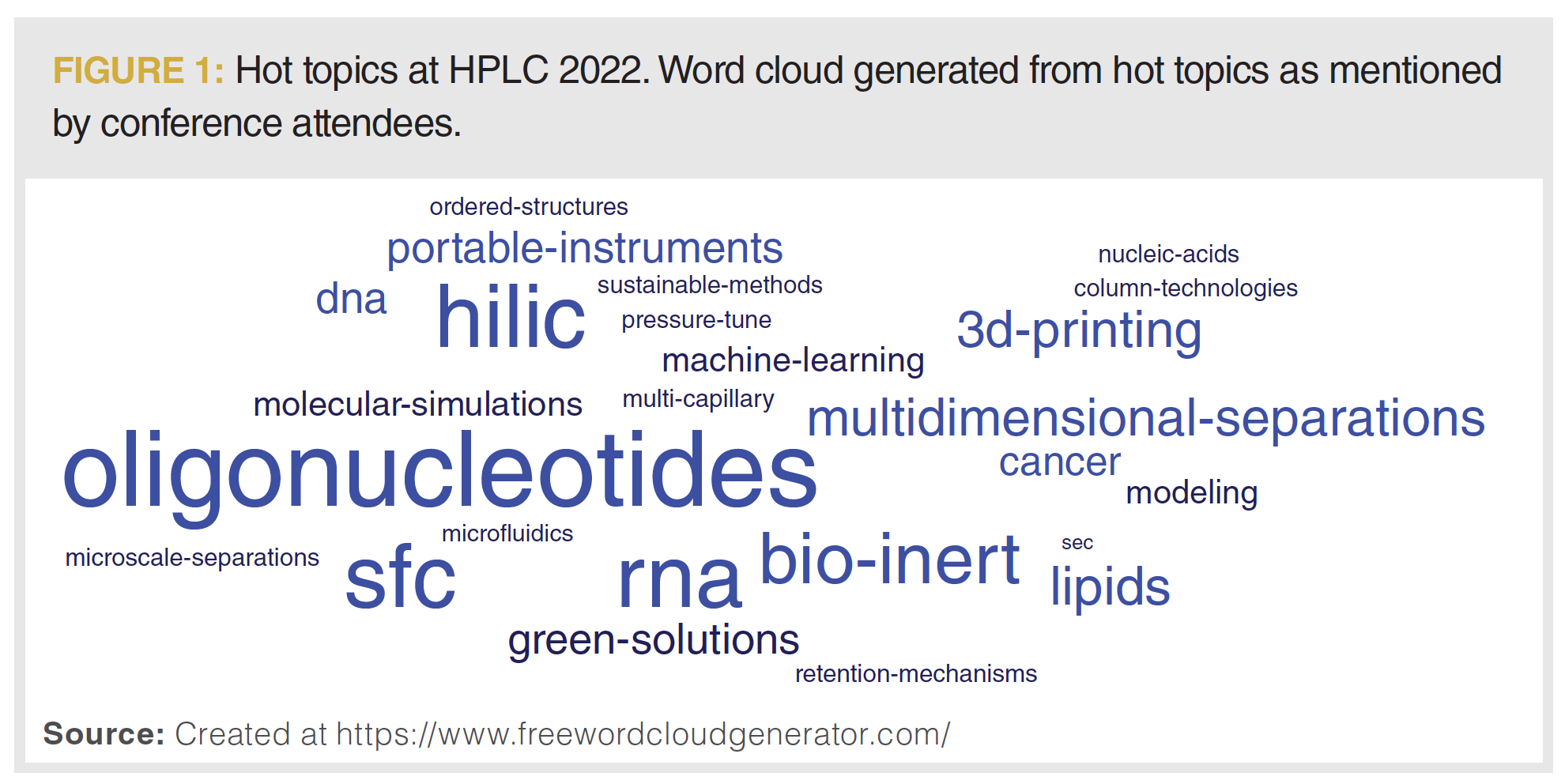
Column and System Technologies
The topic of column technologies immediately took centre stage with the opening plenary lecture by Gert Desmet of Vrije Universiteit Brussel called, “Technological (R)evolutions in Column Making: Quo Vadis Chromatography?” Desmet provided a historical review of column development and highlighted the concept of Moore’s Law and its pertinence to developments in column technology. The “law” predicts that there will be a certain steady rate of gain in a given area of development until something revolutionary happens to change that rate of gain. Desmet went on to demonstrate how measurements of performance, such as column efficiency, have followed this law pretty well since the 1980s (see Figure 2), and asked the question, “how do we break out of it?” The advantages, disadvantages, and potential for some emerging technologies intended to create highly ordered structures such as three-dimensional (3D)-printing, micro‑machining, and micro-groove columns were discussed and contrasted. It was interesting to learn that the 3D-printing technology has developed enough to create the microstructures necessary for the creation of chromatographic devices, but the time to process is still extraordinarily long and materials amenable to printing are very limited.
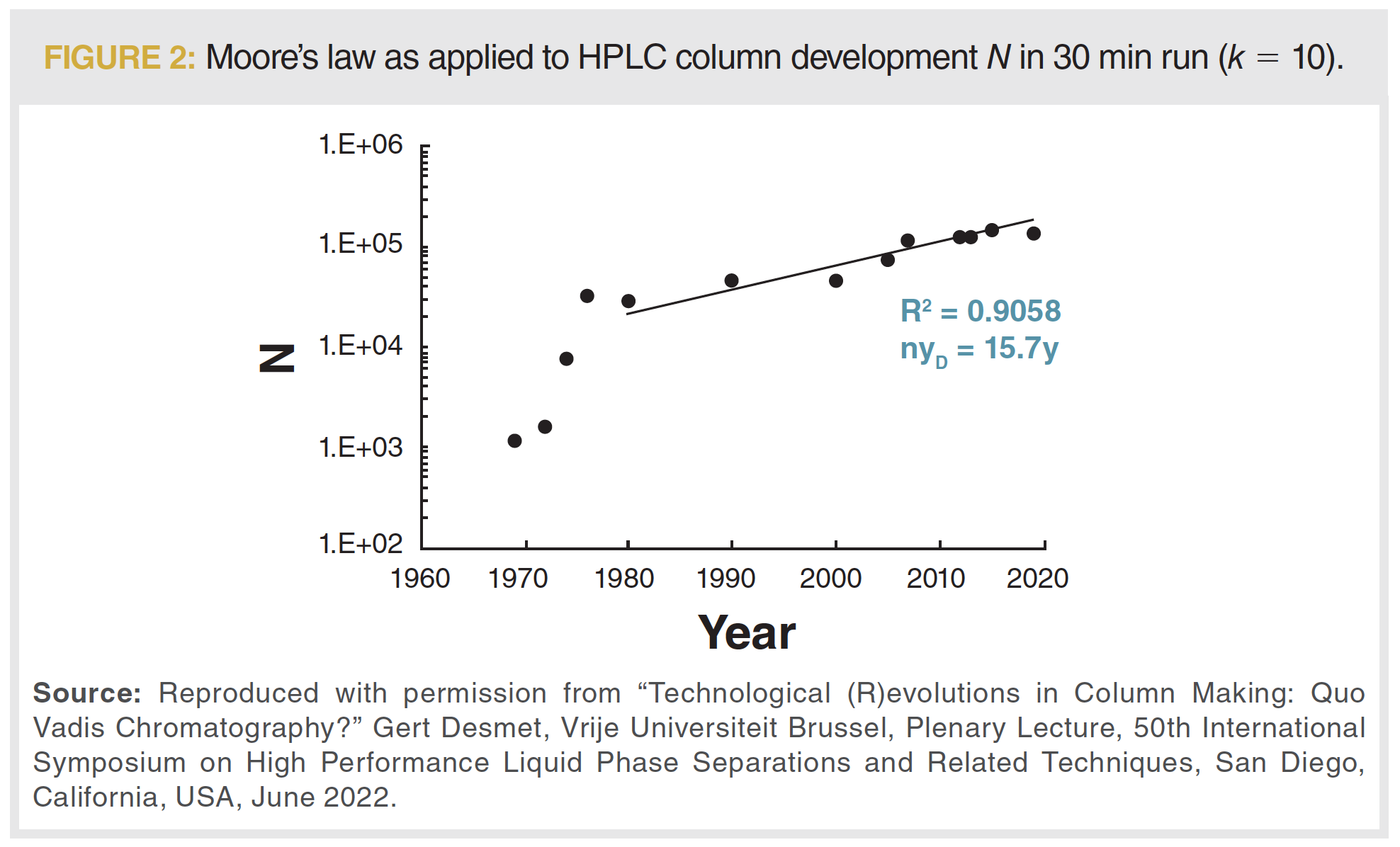
In a plenary lecture entitled “3D-Printed Microfluidics for Solid-Phase Extraction and Biomolecule Separation,” Adam Woolley (Brigham Young University) discussed modern tools in 3D printing to create microfluidic devices for solid‑phase extraction (SPE) and biomolecule separations. By utilizing such a device, Woolley’s group developed a reliable assay for monitoring protein biomarkers for pre‑term birth. In the future, such a small device could be amenable to rapid detection in the clinic in real time; thus, it demonstrates an area of promise for 3D printing. In addition to the Woolley lecture, there was an excellent short course put on by Woolley and Greg Nordin (Brigham Young University) as well as a focus session within the programme featuring noted talks by Nordin and Rosanne Guijt (Deakin University). Although the 3D-printed liquid chromatography (LC) column may be a long way away, 3D printing is certainly gaining ground in the area of microfluidics and integrated fluidic devices.
In addition to 3D printing, there were several other prominent column and system technologies that stood out. These include an increase in the presence and number of portable LC systems, continued advances in microscale separations, and the current trend towards bio-inert or metal-passivated columns and systems.
Portable Instrumentation: Prominent at the symposium was the concept of miniaturized and portable LC instrumentation. Several talks were given, including “A Modular Approach to a Portable Analytical Separation System for Pharmaceutical Analysis” by Llewellyn Coates; “Taking the Chromatograph Out of the Lab: High and Low Pressure Field DeployableInstruments for Environmental Applications” by Brett Paull; “Evolving Capabilities of Compact, Portable Capillary LC” by Milton Lee; “Analysis of Small Molecules in Complex Mixtures using Compact LC–UV-MS Instrumentation” by Samuel Foster; and “Implementation of Compact Capillary LC into Analytical Workflows” by James Grinias. The latter presenter noted in his talk that portability affords “laboratory-to-sample” rather than “sample-to-laboratory”, which could be utilized in improving point-of-care and many environmental analyses. The reduced solvent and power consumption also leads to a lower overall cost as well as moving towards a more “green analytical chemistry” approach. Grinias demonstrated several applications where the portable LC systems were fit for purpose.
The upward trend in the development of portable instruments was also apparent on the exhibition floor with Axcend, Trajan, and CEM (Lucidity) all promoting their latest high performance LC (HPLC) systems.
Microscale Separations: Robert Kennedy of the University of Michigan presented “Capillary LC at 35,000 psi and Beyond for Complex Mixture Analysis”, a talk centred on using elevated pressure, combined with capillary LC–mass spectrometry (MS), to analyze complex mixtures. Kennedy’s group employed longer columns (20–100 cm) in length running at pressures of 35,000 psi to separate lipid and metabolite mixtures. With 1-m long columns, he demonstrated a peak capacity of ~1000 in 3-h analysis times, suitable for complex mixtures. When employing a novel 1.1 µm particle in this format, analysis times were reduced to 1/3 of those achieved by a more conventional 1.7 µm particle in a 15-cm long column at 15,000 psi. Taking this aspect one step further, Kennedy used two-dimensional (2D-) LC (hydrophilic‑interaction chromatography [HILIC] and reversed‑phase liquid chromatography) to analyze the lipid complement of plasma to yield a peak capacity of 1900 in a MS-compatible format (see Figure 3).
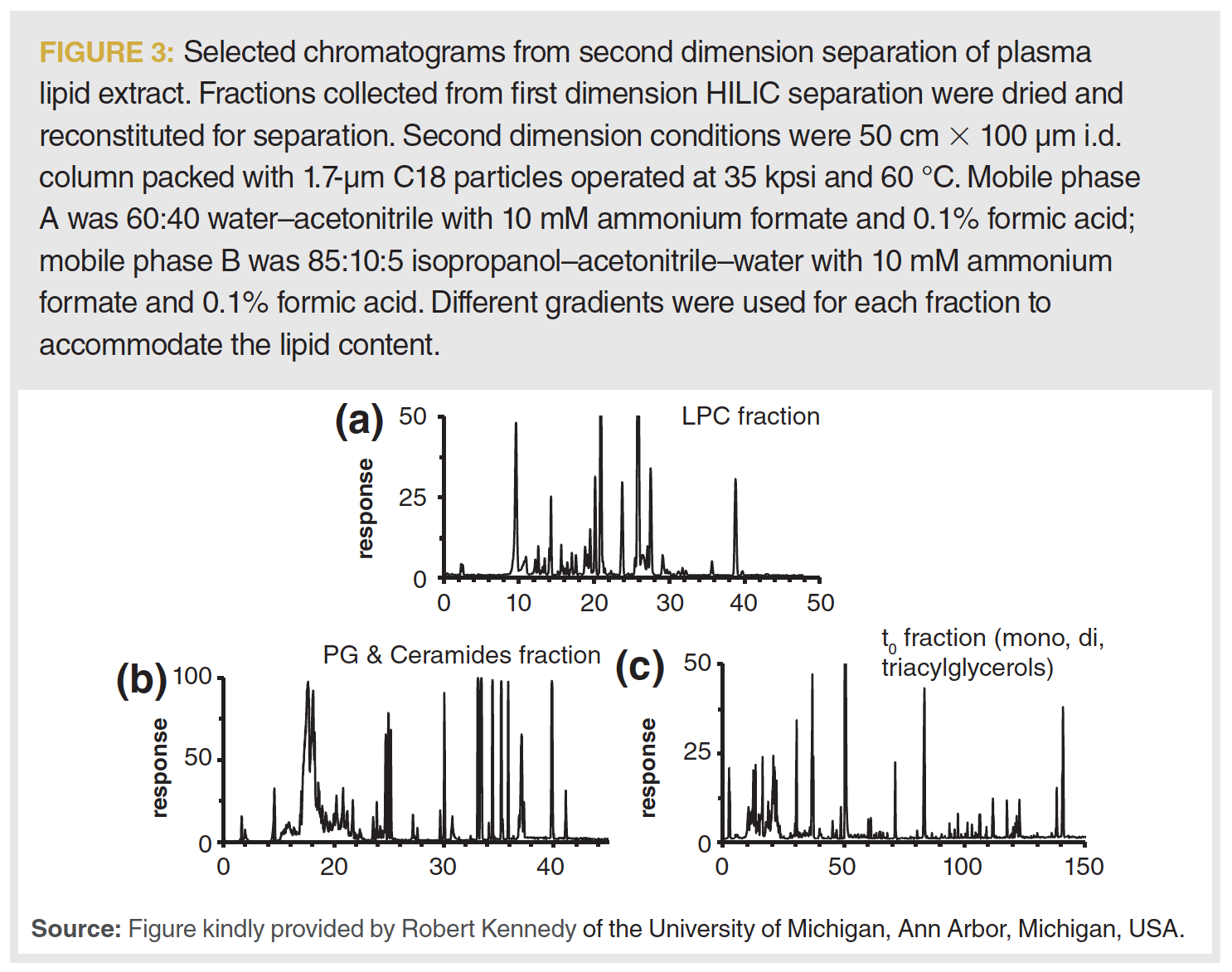
He also reported packing HILIC particles into 75 cm columns at 35,000 psi to yield 213,000 plate separations.
In his talk entitled “Nanoscale Separations to Enable Bottom-up, Top‑down and Native Proteomic Profiling of ng- and Sub-ng-level Samples”, Alexander Ivanov (Northeastern University) employed nano-flow methodologies with narrow-bore monolith columns to achieve sensitive results for analyzing sample-limited protein mixtures in a proteomics workflow. The use of low flow solvent delivery system (12 nL/min) was key to achieving the sensitivity needed in very low abundant protein biomarkers in the clinical specimen.
The need for small sample analyses (for example, in single cells) is proving the need for very narrow columns. Examples were also shown by Ryan Kelly of Brigham Young University in his talk, “Miniaturized LC Separations for Single-Cell Proteomics”. The need for reduced dilution and high resolution is, and will be, key for small samples. The technique also appears to be moving closer to clinical applications as exemplified later in this article under the “Highlighted Areas of Application” section.
Bio-Inert Systems and Columns: The topic of bio-inert or metal-passivated systems and columns was prevalent at HPLC 2022. As noted in the LCGC 2022 review of new LC columns and accessories (4), column and system hardware with various metal passivation strategies have been on the rise recently. David McCalley (University of the West of England, Bristol) kicked off the discussion with a highly cited, Monday morning keynote lecture entitled, “Managing Deleterious Solute Interactions with Metals in Hydrophilic Interaction Chromatography”. McCalley noted that interactions of analytes such as nucleotides and catecholamines with metal surfaces can occur, and there are several ways one may mitigate these undesirable interactions: (1) use columns/systems constructed from metals other than stainless steel; (2) use PEEK- or PTFE-coated systems; (3) use systems and columns deactivated by vapour‑deposition of some “inert” material; or (4) use complexing agents in the mobile phase. Although the focus of the work was geared towards the favourable impact of vapour-deposition deactivated columns and systems, the additional use of high pH as well as low-level complexing agents in the mobile phase provided the best overall separation of the adenosine phosphate probes employed.
In addition to several posters, many vendors were demonstrating their various approaches to bio-inert systems and columns. ThermoFisher displayed their Vanquish systems that replace stainless steel with titanium or MP35N components. Shimadzu showcased Nexera XS Inert, their bio-inert system that utilizes PEEK‑lined stainless steel to offer a metal-free flow path. Waters delivered numerous talks and presented quite a few posters on their Premier systems that utilize chemical vapour deposition of hybrid silica to block metal interactions. Agilent also had their suite of biosystems, which were either metal-free (PEEK) or utilize alternative metal alloys labelled as “iron-free”. Silcotek was also present and showcased their chemical vapour deposition solutions and how their product performance is on par with PEEK when it comes to keeping LC flow paths metal-free.
As noted later in the “Highlighted Areas of Application” section, HILIC was also prominent in various aspects of practical research, and HILIC is also often employed in multidimensional chromatography.
Multidimensional Chromatography:
Multidimensional chromatography was a large part of the show, with two dedicated sessions as well as many lectures utilizing various multidimensional techniques throughout the conference. Peilin Yang (Dow Chemical) presented an excellent lecture entitled, “Multidimensional Separations with Simultaneous Evaporative Light Scattering Detection (ELSD) and MS Detections for Complex Industrial Polymers”, where she showed examples of how comprehensive 2D‑LC can be a powerful tool for polymer analysis. Yang focused her examples on industrial applications such as terpolymer composition heterogeneity, tri-block polymeric impurities, and nonionic copolymer surfactants analysis. Combinations of size-exclusion chromatography (SEC) and reversed‑phase LC, as well as HILIC and reversed-phase LC, were highlighted along with the intelligent use of various detectors based on information needs. Unfortunately, little detail on any additional multidimensional talks and topics were available at the time of writing. However, it is interesting to note that attendee thoughts on the adoption of multidimensional chromatography in the industry varies widely—some indicate a clear adoption whereas others feel this is still solidly in the hands of academics.
Separation Modes
Several separation modes were considered dominant in their presence this year by conference attendees. Notably supercritical fluid chromatography (SFC), HILIC, and multidimensional separations seemed to take centre stage.
SFC: A number of colleagues expressed surprise at the number of presentations focusing on SFC, and many were perplexed by the lack of adoption of SFC in general practice. Some also expressed the sentiment that perhaps SFC is finally breaking through towards acceptance. As for the conference, there were presentations on SFC fundamentals, practical tips and tricks, and, as noted in the forthcoming “Highlighted Areas of Application” section, important real‑world applications in cancer diagnosis.
In his talk entitled, “Measurement and Modelling of Longitudinal Diffusion in Supercritical Fluid Chromatography”, Ken Broeckhoven of Vrije Universiteit Brussel measured both molecular diffusion and longitudinal diffusion (that is, the B-term) in SFC, which allowed the authors to model particle diffusion and surface diffusion, possibly for the first time, in SFC. In another notable talk, Chun-Kai Chang of the University of Minnesota used molecular simulations of the mobile phase composition stationary phase pores to better understand retention mechanisms in SFC in the talk entitled, “Exploration of the Retention Mechanism in Supercritical Fluid Chromatography by Molecular Simulations”. Although they only showed results for C18 surfaces, this work might shed some light on the rather poorly understood retention mechanisms in SFC.
Attila Felinger of the University of Pecs discussed the adoption of methanol on SFC stationary phases in his talk entitled, “Solvent Interactions in Supercritical Fluid Chromatography”. Lucie Novakova of Charles University (“Problems of Stationary Phases in SFC”) followed this up by providing highly practical evidence on how the history of using a column in SFC can strongly affect separation. Columns exposed to additives and organic modifiers may be chemically changed so as to perform differently than the original or a new column. Novakova suggested dedicating columns to certain methods because of this, but also noted that the change is not necessarily permanent. The group is running a large amount of experiments to test a wide range of columns and conditions to find adequate procedures to better understand these findings.
SFC was also noted for its potential as a more “green” technique compared to HPLC. Stefan Lamotte (from BASF) provided a keynote lecture entitled, “The Good, the Bad, and the Ugly - Towards the Separation of Polar Analytes in Supercritical Fluid Chromatography”, where he provided comparisons of SFC with HPLC and HILIC as well as examples of important SFC separations. Lamotte noted that SFC has several real advantages over HPLC including speed of analysis, but noted solubility issues in SFC may need to be overcome. In a post-conference communication, Lamotte added that the chemical industry is clearly being asked to minimize waste and develop sustainable methodologies, and his efforts are clearly moving in the direction of SFC.
HILIC: HILIC was a hot topic of discussion. The topic garnered its own session, and there were several additional HILIC-based talks throughout the conference. As mentioned previously, David McCalley’s talk on the impact of metal passivation in HILIC was a noted highlight. Brady Anderson (University of Michigan) presented a well‑received lecture on the power of HILIC at pressures up to 50,000 psi. Thomas Walter and Jinchuan Yang from Waters Corporation gave excellent talks on characterizing and using a zwitterionic HILIC phase, respectively. Joe Pesek from San Jose State University discussed method development for hydrophilic compounds using aqueous normal phase (ANP) chromatography and contrasted this to HILIC. Although the modes employ similar mobile phase compositions, ANP uses silica hydride-based stationary phases as opposed to more common silica-based chemistries (see Figure 4). Pesek noted that this silica hydride surface exhibits less than one-half a monolayer of water, whereas silica-based columns can have between 4–10 monolayers under similar mobile phase conditions. It is this difference that Pesek surmises results in differences in retention mechanisms (dominant adsorption in ANP compared to dominant partition in HILIC) and other attributes such as fast equilibration. Separation examples are then provided for several important classes of polar analytes.
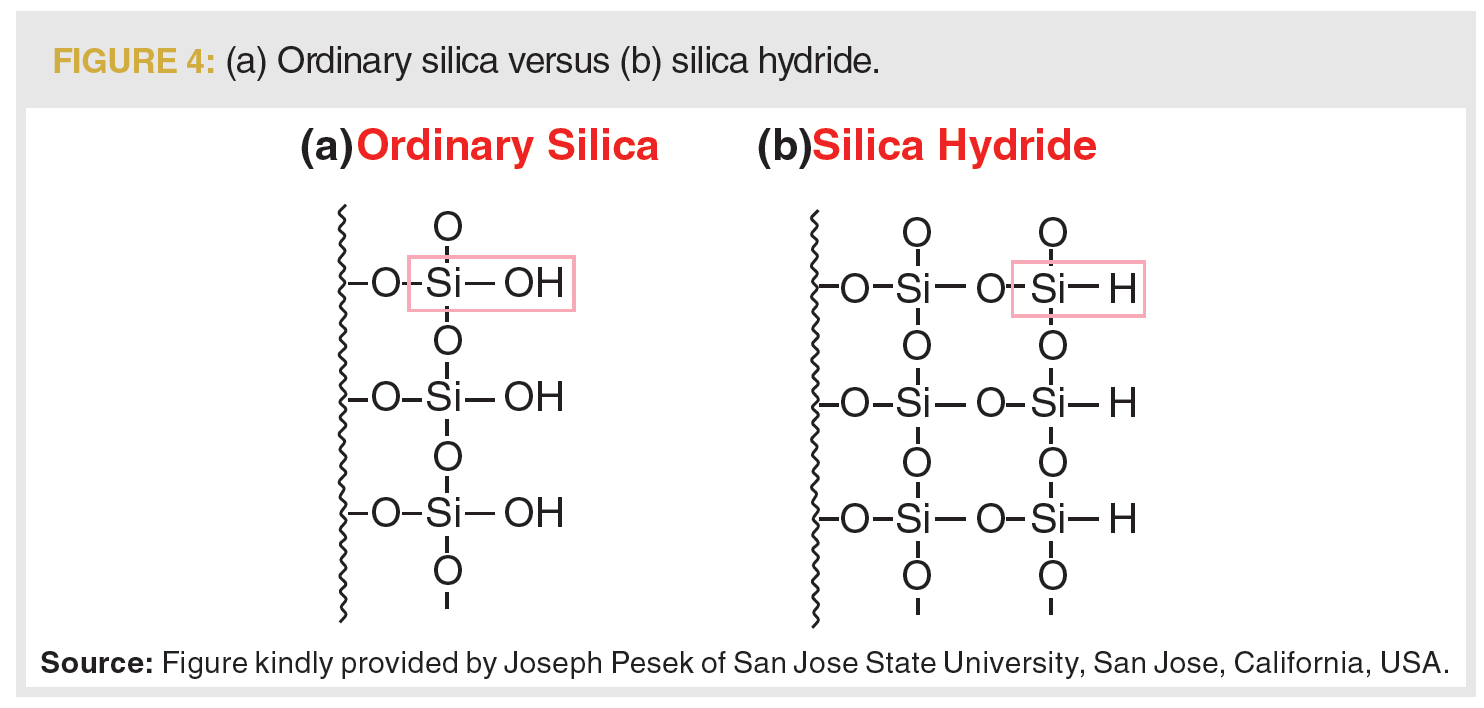
Emerging Topics and Trends
Pressure-Enhanced–Liquid Chromatography (PE–LC): Many colleagues noted Szabolcs Fekete’s talk on how pressure can be used as an additional and unique parameter to tune the selectivity of large molecules in LC as an interesting highlight of the conference. Fekete introduced pressure as a potentially important parameter for selectivity tuning, especially for large molecules, as pressure may impact analyte tertiary structure. Equilibria associated with separation processes such as ionization, adsorption, partition, and complexation are also pressure-dependent. Fekete also noted that pressure may also impact the stationary phase structure and thus the interactions available for retention and selectivity. A system utilizing a pressure-regulating fluid interface was described and utilized to test the retention and selectivity dependence of a set of large and small molecule probes. PE–LC was shown to provide unique separations and be applicable to large molecules. PE–LC also showed efficacy in several modes of chromatography including reversed-phase LC, ion-exchange, hydrophobic interaction chromatography (HIC), and ion-pair reversed-phase LC.
Machine Learning and Molecular Dynamics Simulations:Many attendees noted the increased interest and prevalence of machine learning and molecular dynamics as tools for improving our understanding of chromatographic principles. Two talks on molecular dynamic simulations and model reconstruction of porous media to predict chromatographic separations were given by Ulrich Tallarek from Philipps-Universität Marburg and Fabrice Gritti from Waters Corporation. Gritti contrasted the molecular dynamics approach to more traditional modelling methods such as empirical modelling and rate theory measurements (both with limitations). Although the molecular modelling requires a deep understanding of physical chemistry method and techniques, it may lead to a vast expansion of our knowledge of retention and mass transfer mechanisms as well as improve the robustness of LC modelling.
Machine learning approaches were also noted as an emerging trend. Torgny Fornstedt from Karlstad University gave a talk on ion-pair chromatography of oligonucleotides, discussing the importance of machine learning to interpret and act on the abundance of data collected for these complex analytes. In the following lecture, Imad Haidar Ahmad from Merck & Co. discussed the multifactorial modelling of data for multidimensional chromatography in an attempt to facilitate method development in both one- and two-dimensional separations.
Green Analytical Chemistry: A major theme throughout the conference centred on green analytical chemistry and some of the major topics discussed previously, such as SFC, microscale separations, and even modelling, can be related to this theme. As with other areas of chemistry and life in general, analytical chemists will certainly be called upon to get creative and generate less waste, use less power, and establish overall sustainable methods of analyses moving forwards.
Highlighted Areas of Application
The application of modern separation tools in life sciences was once again prominent at the symposium. Whereas recent HPLC meetings have focused largely on proteomics and related therapeutics (that is, monoclonal antibodies [mAbs] and antibody–drug conjugates [ADCs]), HPLC 2022 also had a strong focus on oligonucleotides, lipids, and the emerging general topic of personalized medicine.
Oligonucleotides, RNA, DNA, and Nucleic Acids:The most recognized applied topic for the conference was centred on the separation of oligonucleotides, including various ribonucleic acid (RNA) and deoxyribonucleic acid (DNA) classes. A simple search of the conference technical programme using the term “oligonucleotide” revealed the topic was highlighted not only in many lectures and posters but also in several vendor seminars and short courses. The focus on oligonucleotides likely stems from the location of the conference (San Diego is a recognized hotbed for oligonucleotide research), recent success of oligonucleotide‑based therapeutics, and, of course, the elevated general community recognition of oligonucleotides because of Covid-19.
In a session dedicated to nucleic acids and oligonucleotides, Kelly Zhang, Claus Rentel, and Alexandre Goyon from Genentech impressed many attendees with their recent efforts in analyzing oligonucleotides using clustered regularly interspaced short palindromic repeats (CRISPR). In her lecture entitled, “Characterization of Guide RNA for CRISPR Gene Editing”, Zhang described methods for characterizing guide RNA (gRNA) for CRISPR gene editing systems and therapeutics. Zhang described ion-pair reversed-phase LC (IP-reversed-phase LC) strategies and noted the best results were achieved by using large pore stationary phases, triethylamine (TEA)- and hexafluoroisopropanol (HFIP)-supplemented mobile phases, and temperatures less than 40 °C to resolve variants. For fine discrimination of gRNA that only differ by one nucleotide, Zhang employed the use of HILIC–MS. Overall, Zhang’s platform of methods includes IP-reversed-phase LC, SEC, and HILIC–MS in analyzing these biotherapeutics.
Rentel discussed the analysis challenges and methods for synthetic oligonucleotides by LC–MS in the paper “Analytical Techniques for Oligonucleotide Therapeutics”. Three different modes of chromatography were employed in characterizing oligonucleotides: ion-pairing, reversed-phase chromatography (IP-RPC) using various IP reagents, weak anion exchange (WAX) chromatography, and metal ion complexation chromatography. The IP-RPC was used to resolve positional isomers of nucleic acids to detect truncated or modified oligos. The WAX chromatography was employed to resolve diastereoisomers and deamidation by-products during formulation. Alternatively, the metal ion complexation chromatography methods were also used to examine diastereoisomers.
In the lecture entitled “Development of Innovative Analytical Approaches for the Separation of Large RNA Oligonucleotide Impurities and Their Sequencing”, Goyon discussed a 2D-LC–MS platform to analyze these impurities. The first-dimension column was packed with various nuclease enzymes to digest the large oligonucleotides into smaller fragments that would be more amenable to ionization and interpretation in the MS instrument. Goyon shared with the audience that this technique is successful in allowing for the detection of very minute modifications in the oligonucleotide product, including even single oxidation events on one nucleotide. The second-dimension column was a HILIC phase because it provided better resolution than several IP-RPC columns and methods.
In a second session dedicated to nucleic acids and oligonucleotides, Gregory Jones of Alnylam Pharmaceuticals discussed ways to automate impurity characterization of oligos utilizing multidimensional chromatography in his talk, “RNAi Therapeutic Impurity Characterization: Workflow Automation using Multidimensional Chromatography”. Also noted as a highlight by several attendees was Ken Cook’s presentation, “Optimization of mRNA Sequence Analysis by UHPLC/HRMS”.
Separation of oligonucleotides is complicated and, as expressed by many of the presenters, requires a number of separation tools. IP-RPC and HILIC appear to be the main modes of separation, sometimes in combination (multidimensional approaches). It was also evident that column and system metal-passivation (bio-inert) is highly desirable for this class of analytes.
Lipids: A highly touted lecture from Michal Holčapek, University of Pardubice, highlighted the use of ultrahigh-performance supercritical fluid chromatography coupled with MS (UHSFC–MS) for high-throughput quantitation of lipids in biological samples. Holčapek described the SFC approach and compared it to HILIC and reversed‑phase LC separation modes (also coupled with MS). Although each mode has its advantages, the UHSFC–MS system offered excellent selectivity and sensitivity (among other attributes) at comparatively short analysis times (see Figure 5). Holčapek went on to describe how the methodology was impressively applied to the early diagnosis of pancreatic and other cancer types. In a post-conference communication, Holčapek noted that “We have already established the spin-off company LipiDiCa (abbreviation of Lipidomic Diagnosis of Cancer), hired [our] first employees, are installing instruments in the laboratories now, and we are working on the preparation of clinical validation, which is a crucial step in our ambitious effort.” The reader is referred to two recent key papers that the presentation was derived from in the literature (5,6).
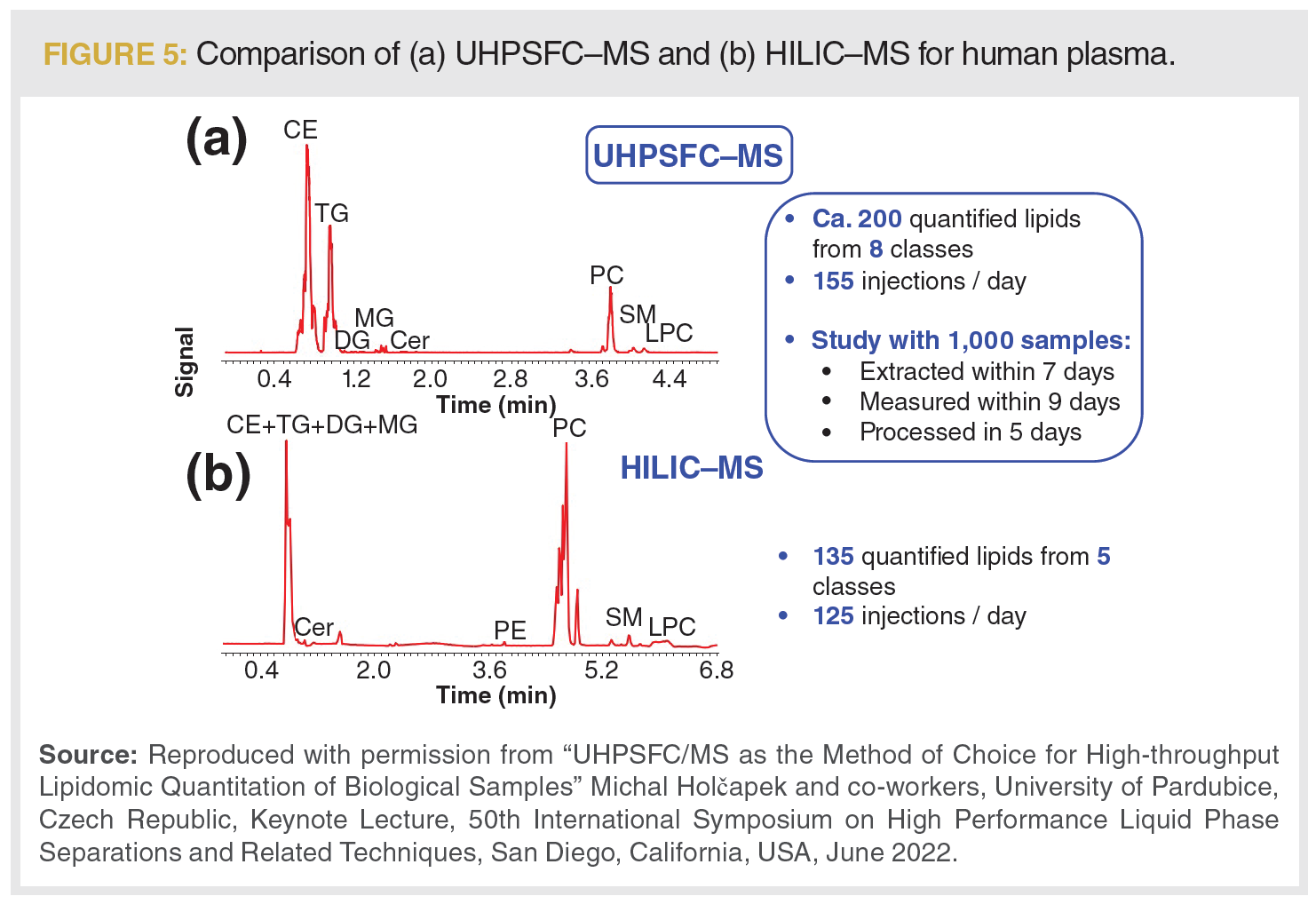
Lipid research was also well represented by both Robert Kennedy (“Capillary LC at 35,000 psi and Beyond for Complex Mixture Analysis”) and Erin Baker (“Combining Multidimensional Measurements with Standards and Isotopologue Workflows to Detect, Identify, and Validate Molecules in Omic Studies”). Analysis of lipids continues to a big opportunity for separation science, as they are challenging analytes to identify with MS alone. Isomers, underdeveloped databases, and a huge range of sizes and polarities make them a gold mine for separations research.
Personalized Medicine: The emerging topic of personalized medicine was very apparent at the meeting. In her plenary lecture in the opening session, titled “Next Phase of Precision Medicine: Application of LC–MS”, Jennifer Van Eyk (Cedars-Sinai Medical Center) discussed the utilization of LC–MS in personalized medicine.
Organ on a Chip/Human on a Chip: Perhaps the most personally memorable lecture of the conference was given by Steven Ray Wilson (University of Oslo) entitled “Organoids, Organ-on-a-chip, and HPLC”. After describing the advantages and disadvantages of current biomedical research models for disease modelling, Wilson introduced the ideas of using organoids, or laboratory-grown organ models derived from human pluripotent stem cells (Figure 6). The research effort aims to couple organoids with LC as a means for improving, among others, precision medicine and drug development. After describing initial success studying the role of oxysterols in non-alcoholic fatty liver disease using a basic “offline” setup, Wilson went on to describe a more elaborate liver “organ‑on‑a‑chip” for drug metabolism studies that utilized electromembrane extraction (EME) to sample solutions in contact with the operative organoid. Lastly, Wilson described packing “columns” with organoids, representing a new area of research where devices could be developed for research purposes (that is, drug metabolism studies) or as bioreactors. For the latter, the potential of a “pancreas-on-a-chip” was assessed by the online coupling of a disulfide bond cleavage reactor prior to MS analysis for measuring excreted insulin. The disulfide bond cleavage was used to fully characterize the insulin released from the organoids when using a nano-LC-based setup.

Conclusions
The HPLC 2022 symposium was a welcome return to face-to-face communication that was well-organized and lively. The meeting once again engaged researchers interested in analytical science from around the globe. The conference was full of new and expanding column and system technologies, offered new insights into many different separation modes, and exhibited important application to our craft in real‑world situations. The meeting also revealed some clear emerging topics such as a focus on oligonucleotide separations, the need for metal passivation of instruments and columns, and the increased focus on green analytical technologies. That said, it was mentioned by many attendees that there were no monumental or revolutionary developments noted at the conference, so it appears the science is still trending in accordance with Moore’s Law. Be it from 3D-printing advancements, developments in microscale separations, or perhaps revelations from molecular dynamics studies, the scientific community lies in anticipation for that next revolutionary discovery.
Acknowledgements
Coverage of such a large symposium is impossible without a great amount of assistance. The authors would like to acknowledge the invaluable input and discussion from Robert Kennedy, Joseph Pesek, David McCalley, Steven Ray Haakon Wilson, Ken Broeckhoven, Mariosimone Zoccali, Michal Holčapek, Alan McKeown, Michael Lämmerhofer, Kevin Schug, Stephen Groskreutz, Andrea Gargano, Martina Catani, Alberto Cavazzini, Fabrice Gritti, Szabolcs Fekete, James Grinias, Michael Dong, Nathaly Reyes, Diego Lopez, Jesse Bischof, Jason Anspach, Mark Schure, and Gert Desmet for providing notes, text, insights, figures, and enlightening discussions.
References
- D.S. Bell, LCGC Europe 30(9), 496–504 (2017).
- D.S. Bell, LCGC Europe 32(10), 544–550 (2019).
- D.S. Bell, C.E. Muraco, and C. Flannery, LCGC Europe 31(11), 628–634 (2018).
- D.S. Bell, LCGC Europe 35(5), 181–186 (2022).
- D. Wolrab, R. Jirásko, E. Cífková, et al., Nature Commun. 13, 124(2022).
- D. Wolrab, R. Jirásko, O. Peterka, et al., Sci. Rep. 11, 20322 (2021).
Cory E. Muraco is the Biomolecule Workflows Manager at MilliporeSigma, the life science business of Merck KGaA, Darmstadt, Germany.
David S. Bell is a Research Fellow in Research and Development at Restek.
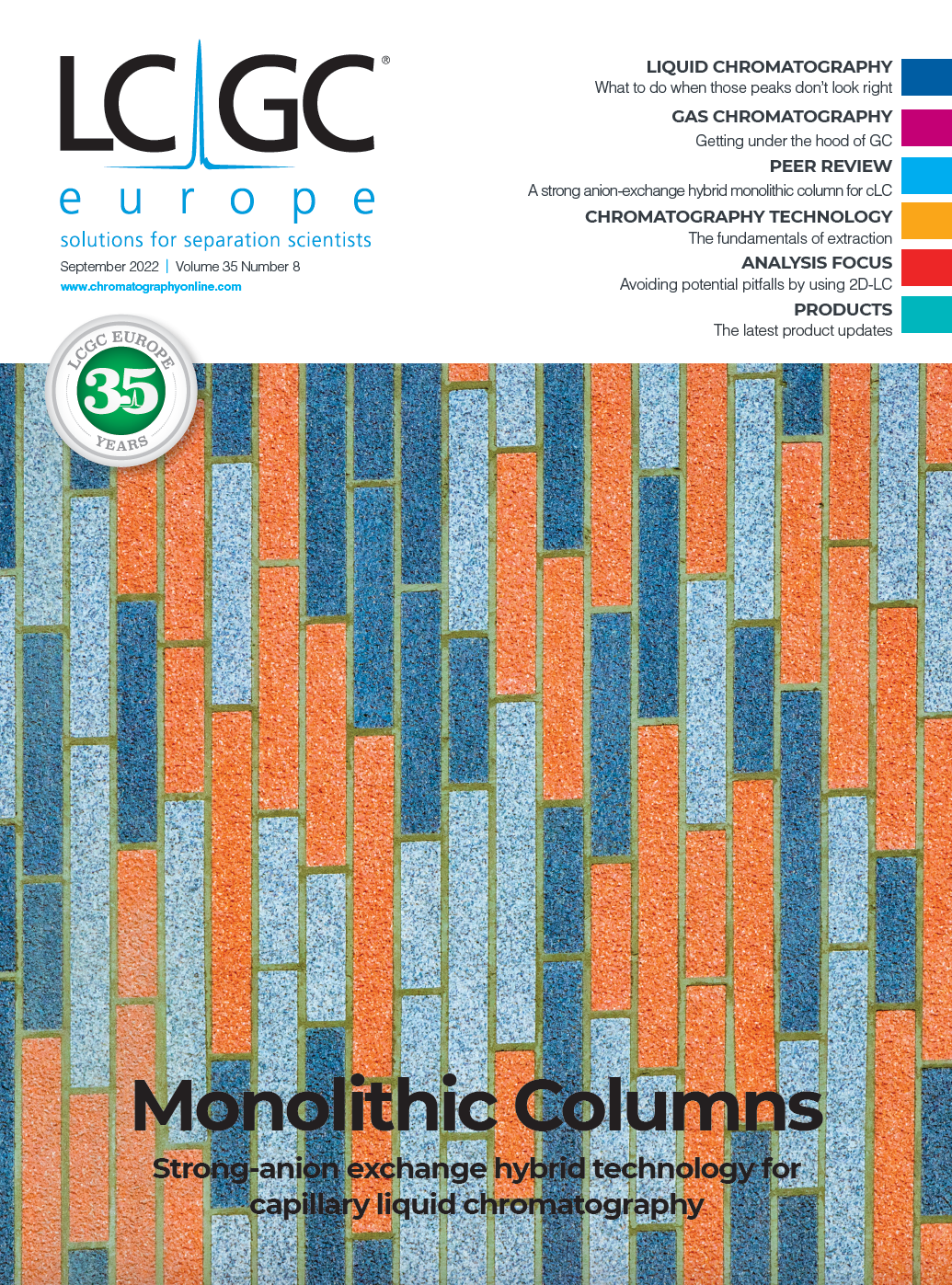
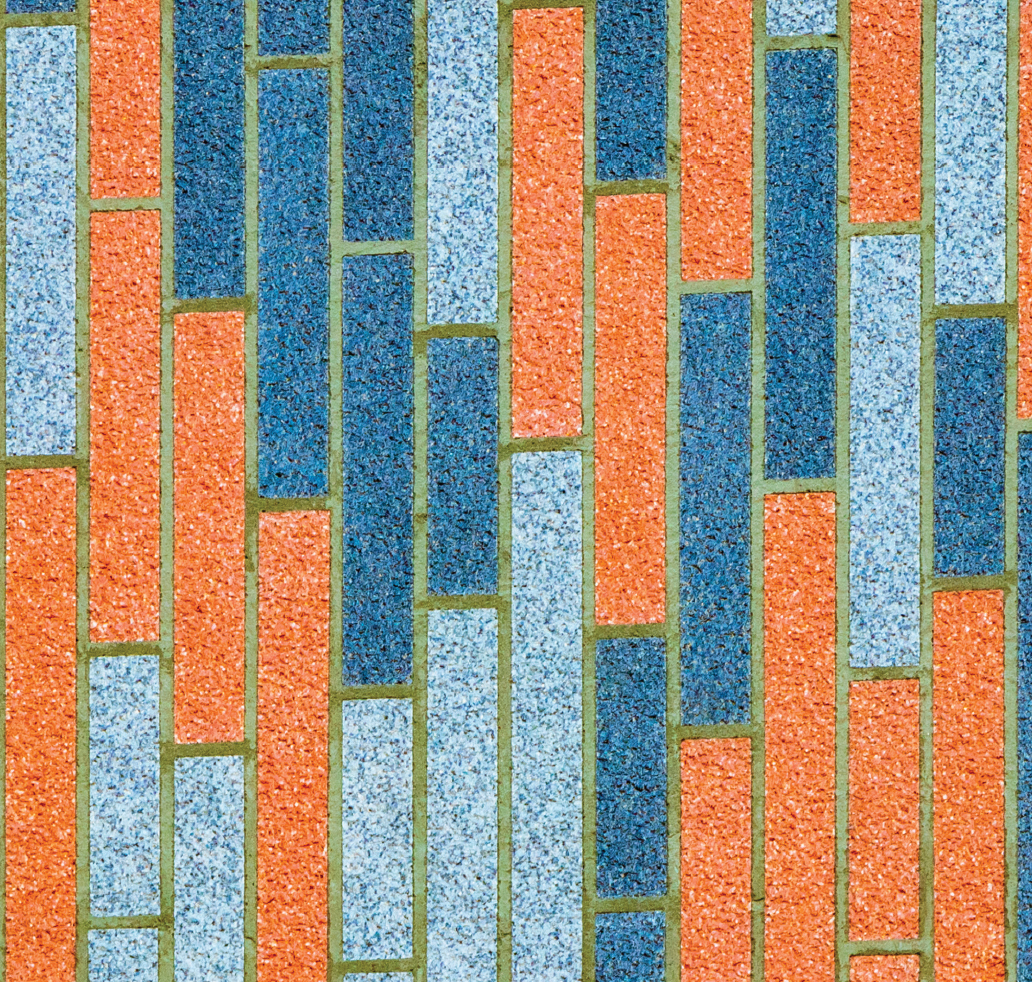





Extracting Estrogenic Hormones Using Rotating Disk and Modified Clays
April 14th 2025University of Caldas and University of Chile researchers extracted estrogenic hormones from wastewater samples using rotating disk sorption extraction. After extraction, the concentrated analytes were measured using liquid chromatography coupled with photodiode array detection (HPLC-PDA).
Polysorbate Quantification and Degradation Analysis via LC and Charged Aerosol Detection
April 9th 2025Scientists from ThermoFisher Scientific published a review article in the Journal of Chromatography A that provided an overview of HPLC analysis using charged aerosol detection can help with polysorbate quantification.
Removing Double-Stranded RNA Impurities Using Chromatography
April 8th 2025Researchers from Agency for Science, Technology and Research in Singapore recently published a review article exploring how chromatography can be used to remove double-stranded RNA impurities during mRNA therapeutics production.
Extracting Estrogenic Hormones Using Rotating Disk and Modified Clays
April 14th 2025University of Caldas and University of Chile researchers extracted estrogenic hormones from wastewater samples using rotating disk sorption extraction. After extraction, the concentrated analytes were measured using liquid chromatography coupled with photodiode array detection (HPLC-PDA).
Polysorbate Quantification and Degradation Analysis via LC and Charged Aerosol Detection
April 9th 2025Scientists from ThermoFisher Scientific published a review article in the Journal of Chromatography A that provided an overview of HPLC analysis using charged aerosol detection can help with polysorbate quantification.
Removing Double-Stranded RNA Impurities Using Chromatography
April 8th 2025Researchers from Agency for Science, Technology and Research in Singapore recently published a review article exploring how chromatography can be used to remove double-stranded RNA impurities during mRNA therapeutics production.


